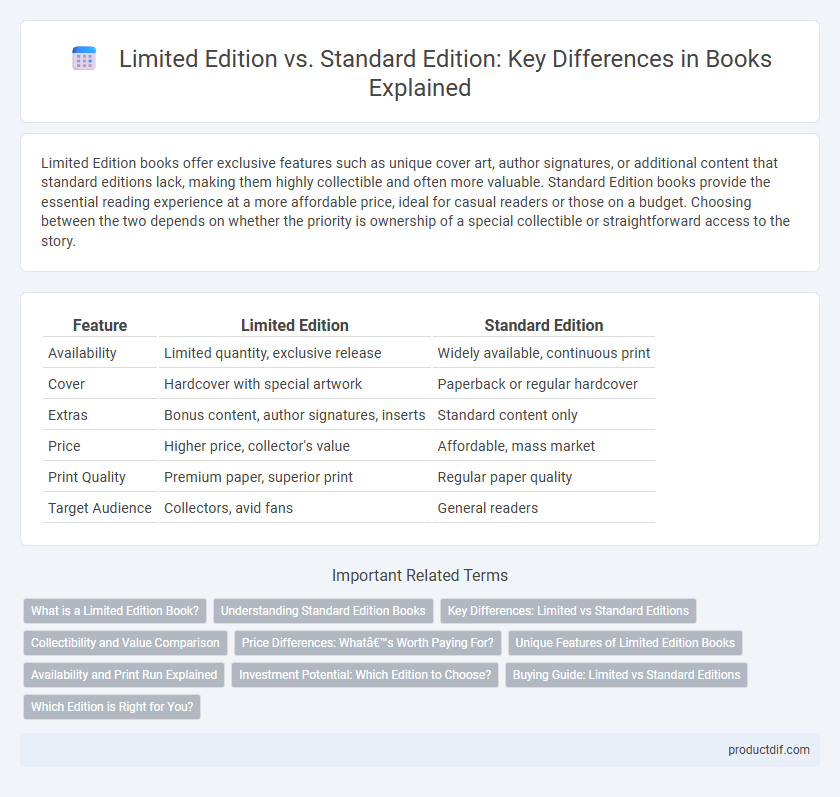Limited Edition books offer exclusive features such as unique cover art, author signatures, or additional content that standard editions lack, making them highly collectible and often more valuable. Standard Edition books provide the essential reading experience at a more affordable price, ideal for casual readers or those on a budget. Choosing between the two depends on whether the priority is ownership of a special collectible or straightforward access to the story.
Table of Comparison
| Feature | Limited Edition | Standard Edition |
|---|---|---|
| Availability | Limited quantity, exclusive release | Widely available, continuous print |
| Cover | Hardcover with special artwork | Paperback or regular hardcover |
| Extras | Bonus content, author signatures, inserts | Standard content only |
| Price | Higher price, collector's value | Affordable, mass market |
| Print Quality | Premium paper, superior print | Regular paper quality |
| Target Audience | Collectors, avid fans | General readers |
What is a Limited Edition Book?
A limited edition book is a specially produced version that features unique qualities such as exclusive cover art, higher quality paper, or author signatures, often restricted to a certain number of copies. These editions are designed for collectors and enthusiasts seeking rarity and enhanced value compared to standard editions. Limited edition books typically include numbered prints and may have supplemental content not found in standard versions.
Understanding Standard Edition Books
Standard edition books offer the core content without extra features, making them more affordable and accessible for readers. These editions typically contain the same text as limited editions but lack special bindings, autographs, or bonus materials. Readers seeking a straightforward reading experience often prefer standard editions due to their availability and cost-efficiency.
Key Differences: Limited vs Standard Editions
Limited Edition books often feature exclusive content such as signed copies, unique cover art, or enhanced materials that are unavailable in Standard Editions. Standard Editions typically focus on mass-market accessibility, providing the core text without additional collectibles or premium packaging. Collectors and avid readers prioritize Limited Editions for their rarity and potential value appreciation over time.
Collectibility and Value Comparison
Limited edition books often feature unique cover art, higher-quality materials, and numbered copies, making them highly collectible and valuable over time compared to standard editions. Collectors seek limited editions for their rarity and potential appreciation in value, whereas standard editions typically serve general readership with lower market demand. The scarcity of limited editions drives exclusivity, positioning them as prized assets in literary collections.
Price Differences: What’s Worth Paying For?
Limited edition books often command higher prices due to exclusive features such as unique cover art, signed copies, or additional content not found in standard editions. These premium elements enhance collectibility and perceived value, justifying the price gap for avid readers and collectors. Standard editions, by contrast, provide accessibility and affordability without the extras, making them a practical choice for everyday reading.
Unique Features of Limited Edition Books
Limited Edition books often boast unique features such as numbered copies, exclusive cover art, and higher quality materials like acid-free paper or leather binding that distinguish them from Standard Editions. These editions may include author signatures, special illustrations, or bonus content not found in the regular print, enhancing their collectible value. The enhanced craftsmanship and rarity of Limited Editions make them highly sought after by collectors and bibliophiles.
Availability and Print Run Explained
Limited Edition books have a restricted print run, often ranging from a few hundred to a few thousand copies, making them highly collectible and scarce compared to Standard Editions, which are produced in larger quantities. Availability of Limited Editions is typically confined to pre-orders, special events, or select retailers, whereas Standard Editions remain widely accessible in bookstores and online platforms. The limited print run of Limited Editions not only enhances their exclusivity but also often results in higher value over time due to their rarity and unique features such as signed copies or premium materials.
Investment Potential: Which Edition to Choose?
Limited edition books often hold higher investment potential due to their scarcity and unique features such as special bindings, signed copies, or exclusive content, which can significantly appreciate in value over time. Standard editions, while more accessible and affordable, generally lack these distinguishing characteristics that attract collectors and investors seeking rarity and exclusivity. Choosing a limited edition is preferable for investors focused on long-term value growth and collectible appeal.
Buying Guide: Limited vs Standard Editions
Limited Edition books feature exclusive content, premium covers, and are often numbered or signed, offering collectors unique value and potential investment growth. Standard Editions provide wider availability, affordable pricing, and essential content, making them suitable for everyday reading and broad audiences. When choosing, consider budget, collectible interest, and whether exclusive features justify the higher cost.
Which Edition is Right for You?
Limited Edition books often feature exclusive content, premium materials, and collectible packaging appealing to avid readers and collectors seeking a unique experience. Standard Editions provide affordability and accessibility, perfect for casual readers who prioritize content over extras. Choosing the right edition depends on your budget, interest in collectible value, and desire for additional features beyond the core narrative.
Limited Edition vs Standard Edition Infographic

 productdif.com
productdif.com